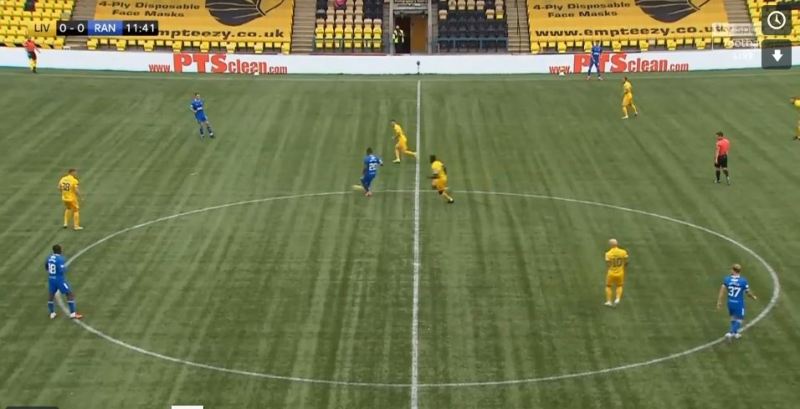Rangers start to the season has brought about many plaudits, not just on the strength of their defense as they set a British football record of starting a season with 7 clean sheets, but also their ability to marry efficient attacking performances alongside them.
In this piece we are going to understand the progression of the team since our last article, which outlined some of the problems in attack vs Livingston, against that of their last league outing against Dundee United.
Build Up Play
While the opposition’s defensive strategy differed between the match at Almondvale and that found at Ibrox last weekend, I felt the biggest difference was Rangers ability to manage the spaces afforded to them by the opponent.
While Livingston dropped off and sat in a lower block with less initial pressure on the entry ball, there were still gaps afforded to Rangers that when the ball progressed into the midfield it didn’t match up with how they wanted to attack in the final third. In this example we see Jack and Kamara dropping in front of the opposition midfield to find space, but then so does Morelos, coming from center forward, to receive a ball from Jack therefore rendering any ability to progress the ball forward meaningless if it goes straight back to the center backs and the opposition haven’t had to go anywhere.

In contrast Rangers build up play was far more efficient against Dundee United, here we look at how they positioned their midfielders and how they moved the ball through the thirds.
Forward Play
Against Livingston Rangers used a very central structure to attempt to breakdown their opponent. While the intent was to attack the spaces between Livingston’s lines with quick combination play, it negated Rangers ability to penetrate the back line as their was no one available to receive a through pass by making a 3rd man run.

Against Dundee United Rangers altered their attacking structure to focus more on the left wing, using smart rotational movement to pull opposition defenders out of their shape and to create crossing opportunities as soon as the ball entered the wide area.
Transitional Play
Defensive Transitions: While Rangers didn’t really need to use defensive transitions against Livingston, primarily as the opponent failed to register enough attacks to test them, in Dundee United they had an opponent who used counter attacks well and Rangers had to be at their best. This example is everything why Rangers are where they are right now, the energy and desire to get into position was spectacular.
Attacking Transitions: Rangers match with Dundee United was arguably their best performance of the season in terms of their ability to counter attack with speed, numbers and efficiency. Here we take a look at some examples of how Rangers increased their intensity in the first few moments of transition to enable them to create scoring opportunities.
Moving forward Rangers biggest challenge will be their ability to take these elements of positive performance and frame them against which style and strategy their opponents throw at them. There will never be a unilateral answer to winning football games, therefore an appreciation of adaptability is going to be required from this group of players should they wish to stake a serious claim for the title this season.

